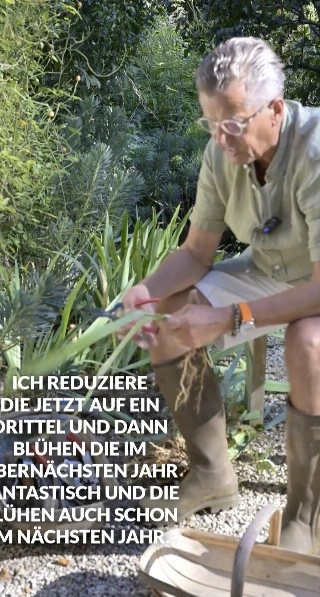
One of my absolute favorite perennials is the iris – especially the Florentine iris, this very special selection from Italy with its centuries-long history. As the heraldic plant of the Medici, it not only has an impressive heritage but is also remarkably robust and adaptable. It also supplies the fragrance industry, as its rhizomes develop a delicate violet aroma after three years of drying.
Propagating this beauty is actually quite simple, although few master the technique. It's a perfect late summer task that I'd like to show you today step by step.
Ideally, you divide iris in July or August. But don't worry – September also works well, as long as it's still warm outside. Alternatively, March-April is suitable. At our location, it's still 25 degrees Celsius, so the roots establish without any problems. The earlier after flowering you transplant the iris, the better they establish in the warm soil.
In my garden, this iris had already become somewhat crowded, surrounded by spurge (Euphorbia characias subspecies wulfenii). To access the iris rhizomes, I first clear away the surrounding plants.
The iris clumps can be pulled out without any issues – this poses no problem for these robust plants. What appears to be a wild tangle is actually a treasure: the iris rhizome, the underground shoot from which the plant grows and draws its strength.
I now reduce these rhizomes to about a third of their size. Disproportionately large rhizomes can simply be broken through – no delicate work is needed here. The important thing is to trim the roots somewhat and remove all rotten, dead parts. For this, I use sharp scissors (mine are from Japan – incidentally, Japanese gardening tools are the best in the world!).
Very important: The above-ground plant parts must be trimmed into a triangular shape. Cut back the foliage so that a triangular form emerges. This allows the plant to continue producing chlorophyll, and you know it's still alive.
What remains is a finished, transplantable rhizome with a stem. When I place these in moist, sandy, but calcareous soil with a bit of humus, they will sprout again from that spot.
When planting, I make sure that the rhizomes, which should protrude from the soil, point backward. I form a circle with the plants and then work my way inward.
A fascinating detail: You can often already guess the flower color at the neck of the rhizome. A purple shimmer indicates a purple variety. White remains white, yellow remains yellow, and so on. There are thousands upon thousands of cultivars in nearly all colors, including multicolored ones and even a chocolate-colored, coppery variety that actually smells like dark chocolate!
What makes the iris so special: It's a true climate plant that effortlessly withstands extreme heat and drought. In its rhizome, it stores water like a cactus – all energy is stored there to endure even severe droughts.
That's why I like to use them in large areas in the Mediterranean region. I've planted whole "batteries" of them in Spain. They actually grow throughout Europe but need plenty of sun and warmth. In Scandinavia, they are difficult to establish, but in Germany, they thrive wonderfully in exposed, sunny locations. They grow best in southern Germany.
For my iris, I've created a kind of "mini-Tuscany": a mixture of limestone, humus, and some clay, with special attention to good drainage. The iris absolutely cannot tolerate waterlogging!
Since my compost is slightly acidic, I mix in shell lime to balance the pH. I sieve everything finely – just as cooking should be fun, so should gardening!
The newly planted irises will already show a few flowers next spring, but they will only display their full splendor the following year. When I've finished planting, I gently press everything down with my hand – the "five-pronged digging fork" is still the best tool.
I might sometimes be smiled at when I plant my small rhizomes: "What, that's supposed to become an iris bed?" But in two years, the area will be densely covered with irises and display a wonderful profusion of blooms in April and May.
The beautiful thing about planting is that you look into the future. Even as I plant, I see in my heart the next year before me, the spring, the flowers. When the irises begin to grow, I know: Spring has arrived.
By the way – in mild, damp autumn days and even in winter, the roots continue to grow as long as there is no severe, persistent frost. And you can also feel the climate in the irises: In the past, they bloomed in Germany only in May-June; today, they already bloom in April.
With each gardening year, not only does the plant grow, but also our intimate connection to it. This iris, which once bloomed in the venerable gardens of the Medici, comes from Villa Gamberaia in Florence, a personal gift from the head gardener Paolo. The Florentine lily, the coat of arms of the Medici and also the Bourbons, is exactly this iris. It spent two decades in my own Italian garden on Lake Maggiore before finding its way to Hamburg. Here it thrives just as magnificently in its new home, if you rejuvenate it every year. Otherwise, age threatens to overwhelm it. In Tuscany, it survived because it always remained a sought-after export good that found its way to the perfumers in Grasse, Provence.
We use cookies to personalise content and to analyse our traffic. You consent to our cookies if you continue to use our website.